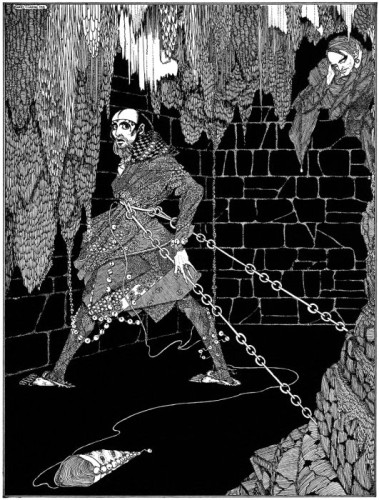 "The Cask of Amontillado" by Edgar Allan Poe
"The Cask of Amontillado" by Edgar Allan Poe Published by Godey's Lady's Book on November 1846
Source: On shelves
Genres: Horror, Short Story
Pages: 9
Format: Paperback
Purchase at Bookshop.org
Add on Goodreads

"The Cask of Amontillado" is set in an unnamed Italian city at carnival time in an unspecified year, and is about a man, Montresor, taking fatal revenge on Fortunato, a friend who, he believes, has insulted him. Like several of Poe's stories, and in keeping with the 19th-century fascination with the subject, the narrative revolves around a person being buried alive—in this case, by immurement.
I don’t read much horror, but Michelle is hosting read-alongs of three of Poe’s short stories at Castle Macabre this month and they fit in so well with RIP X that I decided to join her on a couple. My daughter is a huge Poe fan, so I borrowed her paperback copy of Great Tales and Poems of Edgar Allen Poe.
I wasn’t sure about reading The Cask of Amontillado. Being buried alive is one of my fears, silly I know but that’s beside the point. I may have read too many stories like Poe’s when I was younger, but the victim here is bricked into a wall, which is somehow different.
I don’t want to tell too much about the story, it’s only 9 pages long and you really should just take the few minutes and read it. A couple of things really stuck me, though. First is, as always, how much good short story writers can cram into those pages, how every word, every phrase, every description has to count.
Second, part of the horror in this novel, aside from the going deep underground in a damp vault filled with bones, is we don’t know what Fortunato did to provoke Montresor’s anger. Montresor is the story’s narrator, but we are only told that he is angry over a thousand injuries and a final insult. Even in the end, as he’s using stone and mortar to shut Fortunato in, he mocks him, taunts him, but never does the traditional explanation of why he’s doing it. We get a hint: “You are rich, respected, admired, beloved; you are happy, as once I was,” but we can’t tell if the insults actually happened or if Montresor imagine them.
The other thing that stood out were the contrasts. There is Carnival, joyful, colorful, a day of freedom, which contrasts with the dark, damp trip underground to the vault and eventual, for Fortunato, confinement. Beyond that, even more noticeable are the differences between Montresor and Fortunato. Montresor is dressed in black, crazy, determined, serious. Fortunato is dressed as a court jester in a multi-colored outfit with bells on his hat, he’s drunk and hoping to the end that it is all a joke of some kind. We know the story is going to have a horrific ending, but there are times when you hope Montresor will back out of his plans.
Poe can be a bit difficult to read with a slightly old-fashioned vocabulary and sentence structure, but definitely worth reading. Next week is “The Fall of the House of Usher” and I’m hoping to read “The Murders in the Rue Morgue” this fall too.


I am always impressed by what you choose to read!
I have claustrophobia problems myself. I think it’s different here because Poe isn’t, in excruciating detail, putting us through being buried alive. Instead he’s telling us what it might be like to bury someone alive. Which might be an even more uncomfortable situation…
You might be right – it might be the point of view that makes it okay.
Great write up! Yup, I mentioned the claustrophobia thing myself in my post. No thanks! I too found myself wondering what Fortunado could have done to warrant such an end. And again, it could have been just a mere slight. I guess that’s up to our imagination. The film I mentioned in my post, Tales of Terror, has a variation of this story, titled The Black Cat and it gives one explanation as to why Montresor seeks revenge. You might want to give it a watch if you like old movies and Vincent Price (I adore him!). Here’s this week’s discussion post:
http://castlemacabre.blogspot.com/2015/09/edgar-allan-poe-cask-of-amontillado.html
Despite not being a big fan of short stories and never having read Poe (I’ve always associated him with very dark books) I’m strangely drawn to this one. Thanks for featuring, I’ll be sure to keep a look out.
I love Poe (and this one) and need to read a few stories for Halloween 🙂 I think my favorite has always been Tell Tale Heart, bnut an old friend turned me on to The Black Cat which I loved too. Poe is a master. Watched The Raven, a fictional account of Poe’s last days and it only made me want to know more!
Nice review! I love how you pointed out the contrasts as ways Poe heightens tension. I do this story with students sometimes because it’s so rich with foreshadowing and allusions. It’s also fun to think about whom the narrator is speaking to (You who know me so well…) I’ve wondered if he is confessing to a priest what with all the religious allusions. Guess we’ll never know.